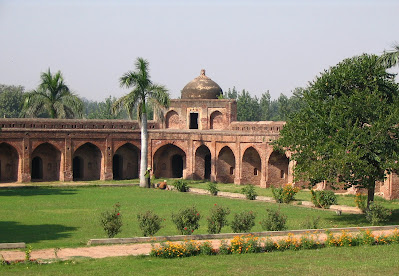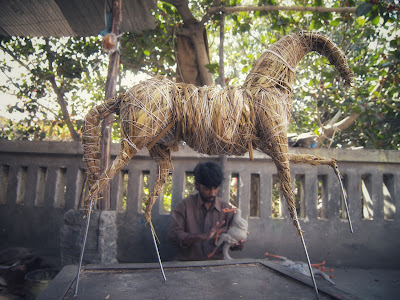 |
| Mural of Ram Durbar in Orchha Fort's Raja Mahal |
A queen of Orchha brought a Ram idol from Ayodhya in the 1570s and established it as the town’s perpetual king in her palace. Locals believe Ram resides in Orchha during the day and returns to Ayodhya at night
As vedic rituals breathed life into Ayodhya’s Ram Lalla idol (Ram depicted as a child) on January 22, 2024, the little town of Orchha in Madhya Pradesh watched agog. For almost 450 years now it has claimed a special bond with Ram’s birthplace. A Ram idol discovered in the Saryu half a century after Mir Baqi built Babri Masjid has presided over Orchha as its Raja ever since. It resides in a grand palace and gets a daily guard of honour. But how this low-lying place deep in Bundelkhand’s woods became a second ‘Ram nagari’ (Ram’s city) is quite a story.
Descendants Of Ram’s Elder Son
Like most Rajput dynasties, the Bundelas of Orchha are wrapped in fantastic legends. Captain CE Luard’s Gazetteer of Orchha says the Bundelas claim to be Suryavanshis like Ram, descended from his elder son Lav.
They got the name Bundela after an 11th-century ancestor, Hem Karan, propitiated the goddess Vindhyavasini Devi by offering her five human heads. She granted him the boon of greatness and the title of Pancham Vindhyela (panch means five). Time changed Vindhyela to Bundela, and the region ruled by the Bundelas became famous as Bundelkhand.
As for Orchha, it was just a patch of woods beside the Betwa river until Bundela king Rudra Pratap went hunting there in the year 1530. He liked it enough to make it his capital, but one of his chiefs, according to the gazetteer, was less impressed and scoffed, “Ondo chhe (it’s low-lying)”. The name stuck.
Ram Comes To Orchha
Rudra Pratap was mauled to death by a tiger within a year, and when his elder son Bharti Chand died childless in 1554, the crown of Orchha passed to the younger prince, Madhukar Shah – “by nature a religious recluse...His Rani (Ganesh Kunwari) was of much the same temperament,” says the gazetteer.
Raja and Rani were both pious Vaishnavites, but historian Meenakshi Jain in her book ‘Flight of Deities And Rebirth Of Temples’ says they differed on one key point: “Madhukar Shah was a worshipper of Krishn while his queen was a Ram devotee”. This created tension between them, and became the cause of Ram’s residence in Orchha.
Art critic Narmada Prasad Upadhyaya’s book ‘Paintings of Bundelkhand’ has an interesting account of the rift between Madhukar and Ganesh Kunwari. It says the Raja went on a pilgrimage to Vrindavan and the Rani to Ayodhya. At their parting, Madhukar challenged Ganesh Kunwari to not return unless she brought Ram with her.
Accounts of what happened in Ayodhya differ. Upadhyaya says the Rani tried to take ‘jal samadhi’ (drown herself) in the Saryu; the gazetteer says she dreamt of a Ram idol hidden in the river, but all agree that she returned to Orchha with an idol. Ramesh Yadav, archaeological officer, ASI Bhopal, says the deity from Ayodhya arrived between 1575 and 1578.
Madhukar and Ganesh Kunwari seem to have been reconciled after this, with the Raja becoming an ardent Ram bhakt himself. Upadhyaya says when Ram’s arrival was celebrated on the banks of the Betwa in Orchha, “Madhukar Shah tied ankle bells and danced”. He also started building a massive temple to house the idol, but Ganesh Kunwari decided to keep it in her palace instead. “She seated him in the kitchen of her palace while converting it into a temple, which exists till date. It resembles Ayodhya’s Kanak Bhawan,” Yadav told TOI.
A Tale Of Two Temples
 |
| Chaturbhuj Temple with the white Ram Raja Temple on the right |
Local lore has it that the Ram idol refused to budge from the Rani’s palace, which therefore became famous as Ram Raja Temple. It’s the only temple in the country where Ram is worshiped as a king. Jain writes in her book: “He wore the turban of royalty, carried a sword in his right hand, and a shield in the left. A guard of honour was held for him every day. Sita wore a crown, and Lakshman was dressed as a prince.” The tradition has been kept alive with police personnel now designated as temple guards. The locals believe Ram rules from Orchha in the daytime and goes back to Ayodhya to sleep at night.
As for Madhukar’s temple project, Yadav says it was finished by his younger son Bir Singh Deo, a contemporary of Mughal emperor Jahangir. An idol of Vishnu was placed inside it so it became famous as Chaturbhuj Temple. Its pine cone-shaped main spire rises to a height of 344 feet and is one of the tallest among Hindu temples.
***
 |
| Chaturbhuj Temple has the tallest vimana or spire among Hindu temples |
 |
| Chaturbhuj Temple |
 |
| Doorway of Ram Raja Temple |
 |
| Ram Raja Temple |









.png)












